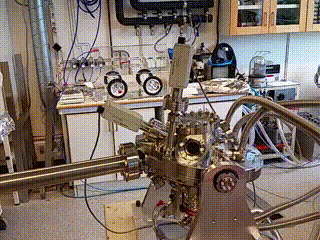Most of the experimental station and the RIXS instrument itself has been an in-house development, where extra care has been taken to optimise the performance, not only in regard to its optical design, but also in regard to mechanical stability and user operation.
VINO Spectrometer

The VINO Spectrometer is designed to cover the energy range of the beamline with as high spectral resolution as possible. The design has been optimised to use the full 10 m length available as well as bending the light towards the floor for stability, putting a limit of 1.2 m vertical deflection of the light. These constraints suggested the use of two Constant Line Spacing (CLS) gratings in a Rowland design instead of the more common Varied Line Spacing (VLS) grating design. A collimating parabolic mirror is used in the horizontal plane, increasing transmission without requiring a very broad detector.
| Energy (wavelength) range | 250 – 1900 eV (50 – 6 Å) using 1st and 2nd order from gratings |
| Energy bandwidth | 30 x 10-3 ΔE/E |
| Horizontal Parabolic Collimating mirror | 1.1 m entrance arm, 2o grazing incidence, side deflecting, 0.4/2 arcsec RMS slope error |
| Grating 1 | At 2.0 m, 1.75 o grazing incidence angle, 1400 l/mm, 0.02/0.1 arcsec RMS slope error |
| Grating 2 | At 2.4 m, 2.0o grazing incidence angle, 1750 l/mm, 0.02/0.1arcsec RMS slope error |
| Delayline detector | 80 mm MCP based delay line detectors with time gating |
Detector and Time-gating
The main detector for the spectrometer at Veritas is a micro channel plate (MCP) detector with a delay-line anode. MCPs offer an excellent performance at grazing incidence angles, something which is required with the Rowland geometry.
A delay-line anode is photon counting and has time resolving capabilities, for Veritas this enables three important features. First, it enables live feedback of the acquisition with spectra updating continuously. Second, synchronisation with the storage ring allows ignoring detector counts that occurs between the X-ray pulses, lowering the MCP dark noise by >80%. Third, it allows synchronisation with external equipment in sub-millisecond timescales.
A second MCP detector is planned to be situated on a swing arm mounted behind a magazine of multilayer mirrors for polarisation measurements.
Q-chamber
The Q-chamber is the main experimental chamber of the RIXS end station (Englund et al., Rev. Sci. Instrum. 86 (2015)). It allows the spectrometer to rotate continuously ±60° in the horizontal plane without the need of venting any part of the vacuum system. The whole manipulator assembly is also removable to allow for special experiments to be mounted directly to the chamber valve.

Manipulator and Sample Environments
The beamline end-station is be equipped with a ultra-high stability four axis manipulator system with exchangeable manipulator rods (Agåker et al., J. Synchrotron Rad. 28 (2021)). While relying on a classical X-Y table and rotation table on a Z tower design, the careful choice of design parameter allowed to achieve high stability, with better than 30nm FWHM vibration and better than 100 nm in positioning and 500 nrad in angular accuracy. Different manipulator rods are available for different sample environments (see below), ad users are also encouraged to develop and bring their own rods for special needs.
Gas Phase
Liquid Jet
Solid State
Two sample rods for solid state environment are available for the moment. A room temperature rod with six available sample slots (three directly grounded and three electrically isolated for drain current detection), and a closed cycle He cryostat from ColdEdge with the possibility of having a very low temperature stage (10 K on the sample) or a manual azimuthal rotational stage.
A two axis version of the He cryo-rod is under development at the moment, making the system fully six axis.
All the present and future rods deigned for solid state sample accept a standard omicron-like flag, inserted in the vacuum system through a load lock port.